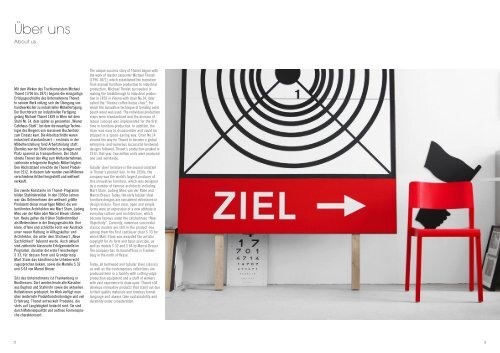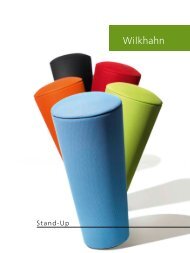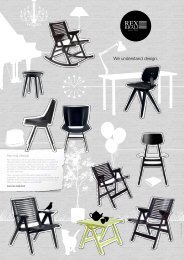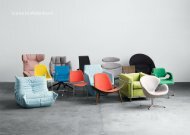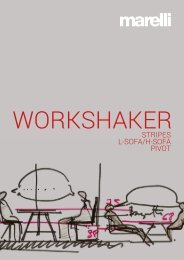Thonet Multifunctional Seating
Sitzen leicht gemacht- mit Thonet.
Sitzen leicht gemacht- mit Thonet.
Sie wollen auch ein ePaper? Erhöhen Sie die Reichweite Ihrer Titel.
YUMPU macht aus Druck-PDFs automatisch weboptimierte ePaper, die Google liebt.
Über uns<br />
About us<br />
Mit dem Wirken des Tischlermeisters Michael<br />
<strong>Thonet</strong> (1796 bis 1871) begann die einzigartige<br />
Erfolgsgeschichte des Unternehmens <strong>Thonet</strong>.<br />
In seinem Werk vollzog sich der Übergang von<br />
handwerklicher zu industrieller Möbelfertigung.<br />
Der Durchbruch zur industriellen Fertigung<br />
gelang Michael <strong>Thonet</strong> 1859 in Wien mit dem<br />
Stuhl Nr. 14, dem später so genannten „Wiener<br />
Caféhaus-Stuhl“, bei dem die neuartige Technologie<br />
des Biegens von massivem Buchenholz<br />
zum Einsatz kam. Die Arbeitsschritte waren<br />
industriell standardisiert – erstmals in der<br />
Möbelherstellung fand Arbeitsteilung statt.<br />
Überdies war der Stuhl einfach zu zerlegen und<br />
Platz sparend zu transportieren. Der Stuhl<br />
ebnete <strong>Thonet</strong> den Weg zum Weltunternehmen;<br />
zahlreiche erfolgreiche Bugholz-Möbel folgten.<br />
Den Höchststand erreichte die <strong>Thonet</strong> Produktion<br />
1912: In diesem Jahr wurden zwei Millionen<br />
verschiedene Artikel hergestellt und weltweit<br />
verkauft.<br />
Die zweite Konstante im <strong>Thonet</strong>-Programm<br />
bilden Stahlrohrmöbel. In den 1930er Jahren<br />
war das Unternehmen der weltweit größte<br />
Produzent dieser neuartigen Möbel, die von<br />
berühmten Architekten wie Mart Stam, Ludwig<br />
Mies van der Rohe oder Marcel Breuer stammten.<br />
Heute gelten die frühen Stahlrohrmöbel<br />
als Meilensteine in der Designgeschichte. Ihre<br />
klare, offene und schlichte Form war Ausdruck<br />
einer neuen Haltung in Alltagskultur und<br />
Architektur, die unter dem Stichwort „Neue<br />
Sachlichkeit“ bekannt wurde. Auch aktuell<br />
sind zahlreiche klassische Erfolgsmodelle im<br />
Programm, darunter der erste Freischwinger<br />
S 33, für dessen Form und Grundprinzip<br />
Mart Stam das künstlerische Urheberrecht<br />
zugesprochen bekam, sowie die Modelle S 32<br />
und S 64 von Marcel Breuer.<br />
Sitz des Unternehmens ist Frankenberg in<br />
Nordhessen. Dort werden heute alle Klassiker<br />
aus Bugholz und Stahlrohr sowie die aktuellen<br />
Kollektionen produziert. Im Werk verfügt man<br />
über modernste Produktionstechnologie und viel<br />
Erfahrung. <strong>Thonet</strong> entwickelt Produkte, die<br />
stets auf Langlebigkeit bedacht sind. Sie sind<br />
durch Materialqualität und zeitlose Formensprache<br />
charakterisiert.<br />
The unique success story of <strong>Thonet</strong> began with<br />
the work of master carpenter Michael <strong>Thonet</strong><br />
(1796-1871), which established the transition<br />
from manual furniture production to industrial<br />
production. Michael <strong>Thonet</strong> succeeded in<br />
making the breakthrough to industrial production<br />
in 1859 in Vienna with chair No.14, later<br />
called the “Vienna coffee house chair”, for<br />
which the innovative technique of bending solid<br />
beech wood was used. The individual production<br />
steps were standardised and the division of<br />
labour concept was implemented for the first<br />
time in furniture production. In addition, the<br />
chair was easy to disassemble and could be<br />
shipped in a space-saving way. Chair No.14<br />
cleared the way for <strong>Thonet</strong> to become a global<br />
enterprise, and numerous successful bentwood<br />
designs followed. <strong>Thonet</strong>’s production peaked in<br />
1912: that year, two million units were produced<br />
and sold worldwide.<br />
Tubular steel furniture is the second constant<br />
in <strong>Thonet</strong>’s product line. In the 1930s, the<br />
company was the world’s largest producer of<br />
this innovative furniture, which was designed<br />
by a number of famous architects including<br />
Mart Stam, Ludwig Mies van der Rohe and<br />
Marcel Breuer. Today, the early tubular steel<br />
furniture designs are considered milestones in<br />
design history. Their clear, open and simple<br />
forms were an expression of a new attitude in<br />
everyday culture and architecture, which<br />
became famous under the catchphrase “New<br />
Objectivity”. Currently, numerous successful<br />
classic models are still in the product line,<br />
among them the first cantilever chair S 33 for<br />
which Mart Stam was awarded the artistic<br />
copyright for its form and basic principle, as<br />
well as models S 32 and S 64 by Marcel Breuer.<br />
The company has its head offices in Frankenberg<br />
in the north of Hesse.<br />
Today, all bentwood and tubular steel classics<br />
as well as the contemporary collections are<br />
produced here in a facility with cutting-edge<br />
production equipment and a staff of workers<br />
with vast experience to draw upon. <strong>Thonet</strong> still<br />
develops innovative products that stand out due<br />
to their quality materials and timeless formal<br />
language and always take sustainability and<br />
durability under consideration.<br />
2<br />
3


